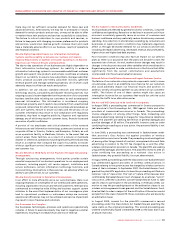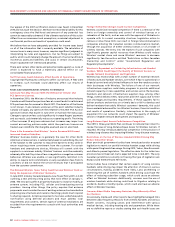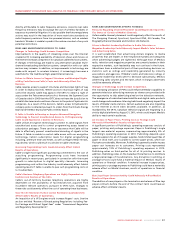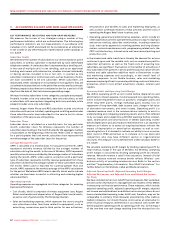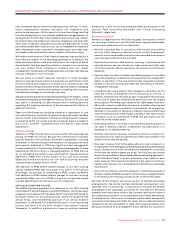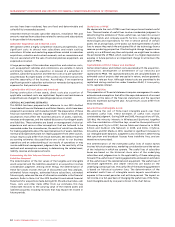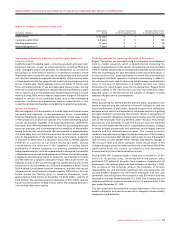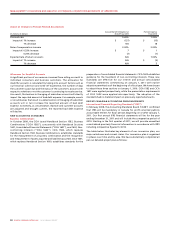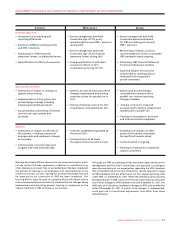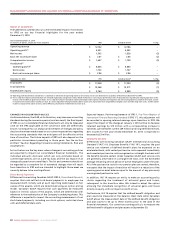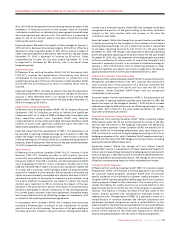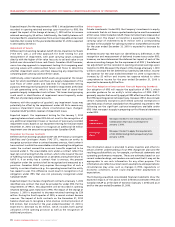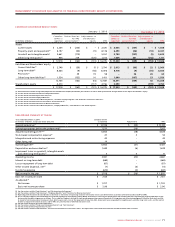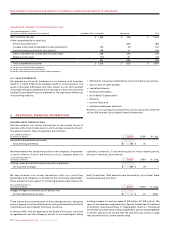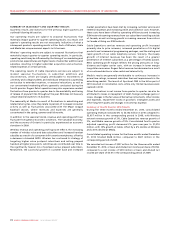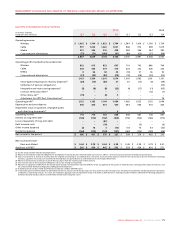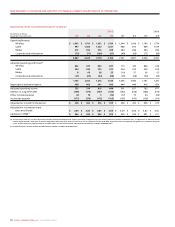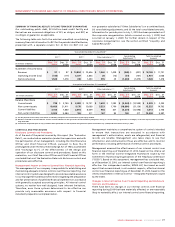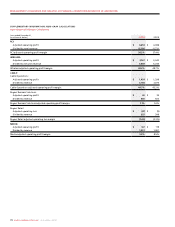Rogers 2010 Annual Report Download - page 65
Download and view the complete annual report
Please find page 65 of the 2010 Rogers annual report below. You can navigate through the pages in the report by either clicking on the pages listed below, or by using the keyword search tool below to find specific information within the annual report.
ROGERS COMMUNICATIONS INC. 2010 ANNUAL REPORT 69
MANAGEMENT’S DISCUSSION AND ANALYSIS OF FINANCIAL CONDITION AND RESULTS OF OPERATIONS
Also, IAS 19 limits the amount that can be recognized as an asset on the
statement of financial position to the present value of available
contribution reductions or refunds plus unrecognized actuarial losses
and unrecognized past service costs. This restriction is expected to
apply to one of our pension plans at the date of transition further
reducing the pension asset.
Expected impact: We expect the impact of these changes at January 1,
2010 will be to decrease retained earnings by $174 million offset by a
decrease in other long-term assets of $121 million and an increase in
other long-term liabilities of $53 million. Net income for the year ended
December 31, 2010 is expected to increase by $5 million. Other
comprehensive income for the year ended December 31, 2010
is expected to decrease by $80 million, due to actuarial losses
being recognized.
Borrowing Costs
Differences from existing Canadian GAAP: IAS 23, Borrowing Costs
(“IAS 23”), requires the capitalization of borrowing costs directly
attributable to the acquisition, construction or production of a
qualifying asset as part of the cost of that asset. Under Canadian GAAP,
we elected the accounting policy choice to expense these costs as
incurred.
Expected impact: IFRS 1 provides an election that permits application
of the requirements of IAS 23 prospectively from the date of transition,
January 1, 2010; therefore there is no change to the opening IFRS
balance sheet. We expect net income for the year ended December 31,
2010 will increase by $3 million.
Fixed Assets: Componentization
Differences from existing Canadian GAAP: IAS 16, Property, Plant and
Equipment (“IAS 16”) requires an entity to identify the significant
component parts of its items of PP&E and depreciate those parts over
their respective useful lives. Canadian GAAP only requires
componentization to the extent practicable. We have identified a small
number of assets with significant component parts that were not
depreciated separately under Canadian GAAP.
Expected impact: Per the requirements of IFRS 1, this adjustment will
be recorded in opening retained earnings upon transition to IFRS. We
expect the impact of the change at January 1, 2010 will be to decrease
retained earnings by $11 million offset by a corresponding decrease in
property, plant & equipment. Net income for the year ended December
31, 2010 is expected to decrease by $2 million.
Joint Ventures
Differences from existing Canadian GAAP: IAS 31, Interests in Joint
Ventures (“IAS 31”), currently provides us with a policy choice to
account for joint ventures using either proportionate consolidation or
the equity method. The IASB is currently considering Exposure Draft 9,
Joint Arrangements (“ED 9”), that is intended to modify IAS 31. The
IASB has indicated that it expects to issue a new standard to replace IAS
31 in early 2011. Currently, under Canadian GAAP, we proportionately
account for interests in joint ventures. ED 9 proposes to eliminate the
option to proportionately consolidate such interests that exist in IAS 31,
and require an entity to recognize its interest in a joint venture, using
the equity method. Consequently, we expect to adopt the equity
method upon transition to IFRS to minimize the impact of the new
standard in the post transition period. The impact of using the equity
method is anticipated to result in reductions of the opening balances
for current assets, property, plant and equipment, intangible assets
and current liabilities with an offsetting increase in investments, with
no impact to the opening retained earnings balance.
In accordance with Canadian GAAP, the Company had previously
recorded a deferred gain in relation to the contribution of certain
assets to one of its joint ventures. The portion of this gain relating to
the other venturer’s interest in the joint venture is being amortized to
income over a seven-year period. Under IFRS, the Company would have
recognized the portion of the gain relating to the other venturer’s
interest in the joint venture fully into income at the time the
contribution was made.
Expected impact: While the change from proportionate consolidation
to equity accounting for the Company’s joint ventures will not impact
opening retained earnings, nor will it impact net income, it is expected
to decrease operating revenue by $41 million for the year ended
December31,2010. The change is also expected to decrease operating
profit and adjusted operating profit by $22 million for the year ended
December 31, 2010. Also, the treatment of the deferred gain associated
with the contribution of certain assets to one of the Company’s joint
ventures is expected to result in an increase in retained earnings at
January 1, 2010 of $15 million with an offsetting decrease to other
long-term liabilities. As a result, net income is expected to decrease by
approximately $4 million for the year ended December 31, 2010.
Financial Instruments: Transaction Costs
Differences from existing Canadian GAAP: IAS 39, Financial Instruments:
Recognition and Measurement (“IAS 39”), requires that transaction
costs incurred upon initial acquisition of a financial instrument be
deferred and amortized into profit and loss over the life of the
instrument. Under Canadian GAAP these costs are recognized
immediately in net income.
Expected impact: Per the requirements of IFRS 1, this adjustment will
be recorded in opening retained earnings upon transition to IFRS. We
expect the impact of the change at January 1, 2010 will be to increase
retained earnings by $58 million with an offsetting decrease to long-
term debt. Net income for the year ended December 31, 2010 is
expected to decrease by $3 million.
Financial Instruments: Hedge Accounting
Differences from existing Canadian GAAP: When assessing hedge
effectiveness under IAS 39, we will be required to include in the test
the risk that the parties to the hedging instrument will default by
failing to make payment. Under Canadian GAAP, we elected not to
include credit risk in the hedge effectiveness tests. Upon transition to
IFRS, we intend to continue to apply hedge accounting to all of our
hedging arrangements for which Canadian GAAP hedge accounting is
applied and that meet the IFRS hedge accounting criteria, including
passing the revised effectiveness tests.
Expected impact: While the change will not impact overall
shareholders’ equity, it is expected to increase retained earnings by $7
million and correspondingly decrease the hedging equity reserve by $7
million at January 1, 2010. Net income for the year ended December 31,
2010 is expected to decrease by $6 million. The change to net income is
offset by a corresponding impact to other comprehensive income.
Customer Loyalty Programs
Differences from existing Canadian GAAP: IFRIC 13 Customer Loyalty
Programmes (“IFRIC 13”) requires a revenue approach in accounting
for customer loyalty programs. Canadian GAAP does not provide
specific guidance on accounting for customer loyalty programs. For
Canadian GAAP, we have adopted a liability approach for our customer
loyalty program offered to Fido subscribers. The current policy is to
classify the liability for loyalty points as an accrued liability on the
balance sheet and to record the net cost of the program in equipment
revenue. The liability is initially recorded at the face value of the
loyalty awards granted and subsequently adjusted based on
redemption rates. The application of IFRIC 13 is expected to result in a
reclassification of revenue between the network (decrease) and
equipment (increase) categories as well as a reclassification on the
balance sheet for the deferred revenue balance from accrued liabilities
to unearned revenue. Furthermore, we will also be required to defer a
portion of the revenue for the initial sales transaction in which the
awards are granted based on the fair value of the awards granted.


